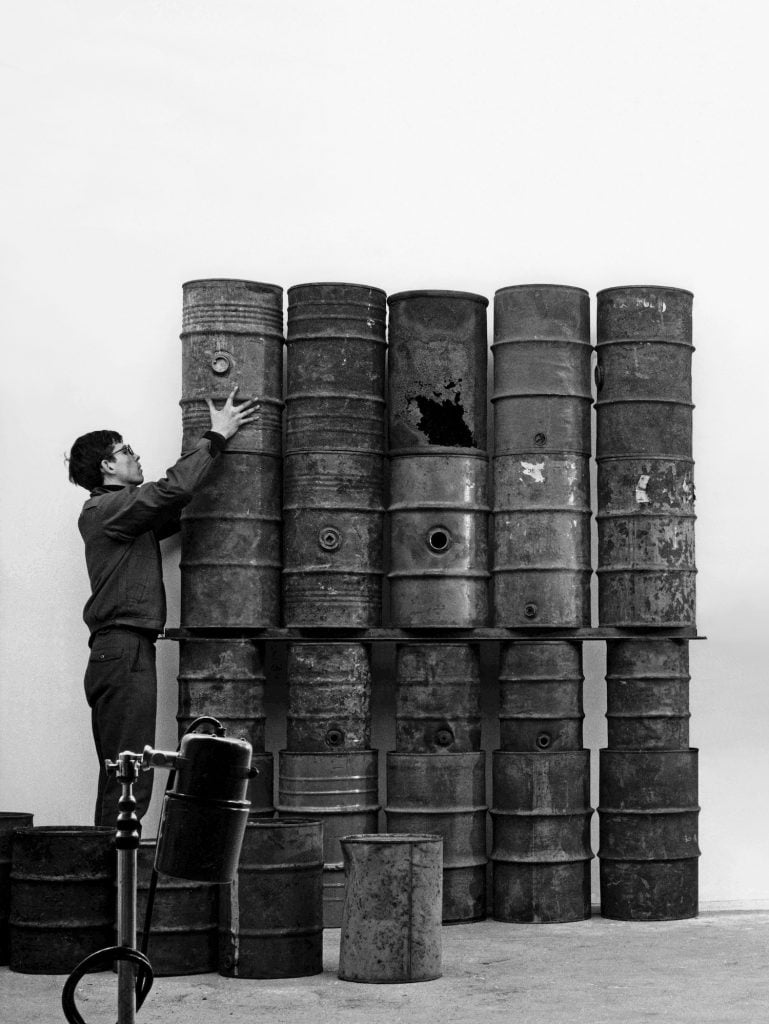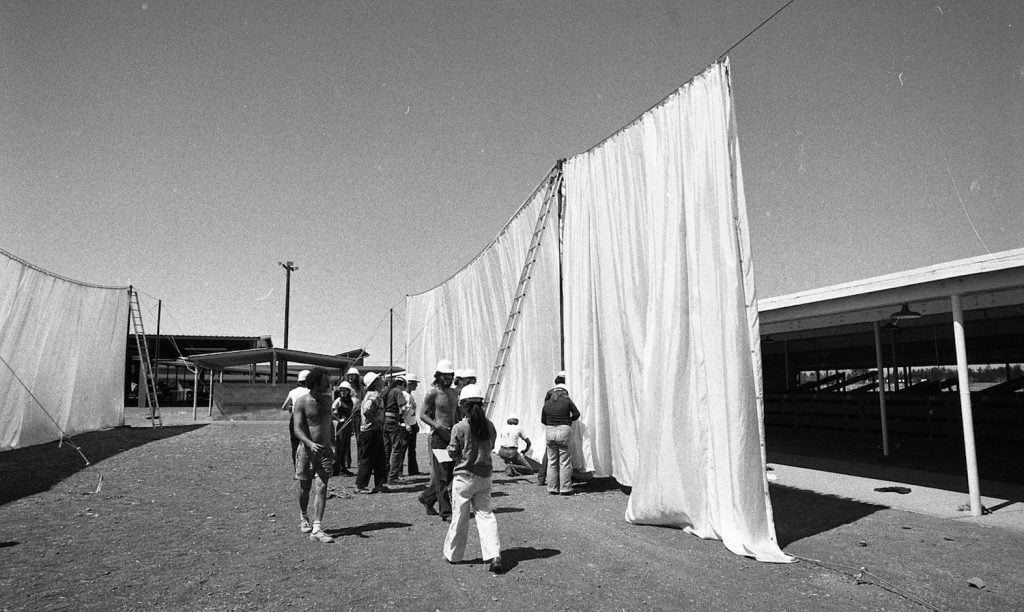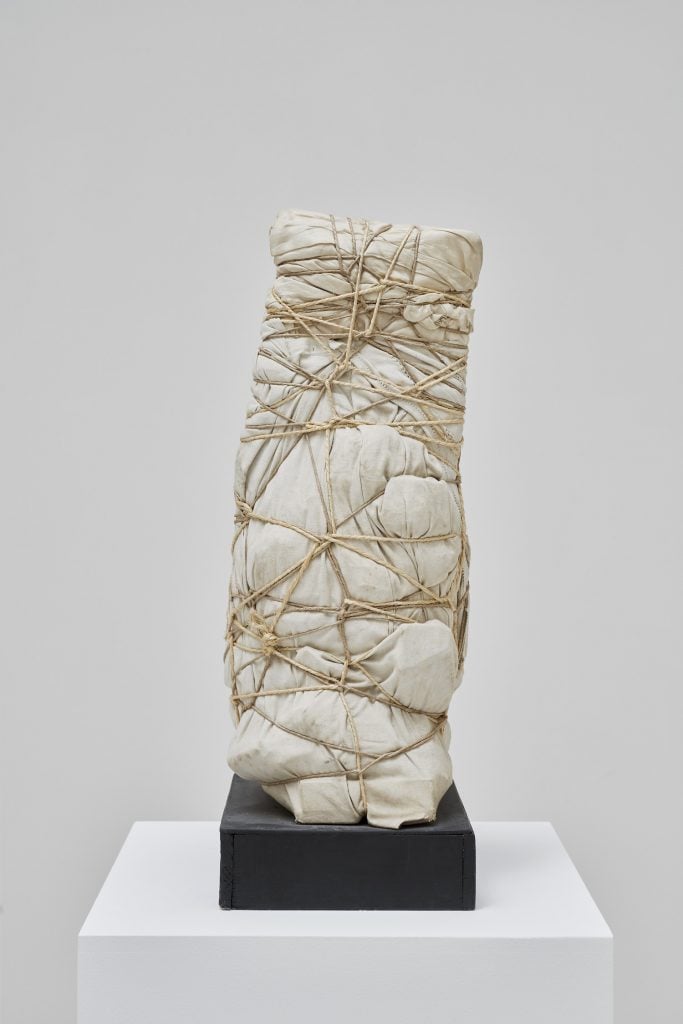Galleries
‘I’ll Never Forget That Moment’: Larry Gagosian on How an Encounter With Christo in His 20s Inspired a New Show of the Artist’s Little-Known Early Work
Gagosian's new show in Paris includes many never-before-seen Christo works.

Gagosian's new show in Paris includes many never-before-seen Christo works.

Eileen Kinsella

He is famous for wrapping the Reichstag in fabric, building piers in Italy’s Lake Iseo that enabled people to walk on water, and erecting saffron-colored gates in Central Park. But far less is known about Christo’s early work.
A new show at Gagosian in Paris aims to offer a window into this formative chapter, when the artist began to experiment with fabric and oil barrels. Organized in collaboration with Christo’s estate, it brings together a variety of sculptures he created in Paris between 1958 and 1963, many of which have never been seen publicly. (Christo died in 2020 at the age of 84.)

Installation view of “CHRISTO: Early Works, 1958–1963,” at Gagosian Paris.
© Christo and Jeanne-Claude Foundation
Photo: Thomas Lannes
Image courtesy Gagosian
For gallery founder Larry Gagosian, the show is the culmination of a long relationship with the artist’s work. Back in 1976, he volunteered to help erect Running Fence, which involved constructing a 24.5-mile wall of white nylon fabric along the hills of Sonoma and Marin counties in Northern California.
“Somebody I knew was very involved with Christo at the time and asked, ‘Do you want to come up and do a little labor?’” Gagosian recalled recently in an interview. “I thought it might be a fun thing to do…. I dug these holes that the poles went into, that the fabric of the fence was stretched across.”
To realize the project, Christo and his wife and lifelong collaborator Jeanne-Claude had to persuade skeptical ranchers to let them temporarily co-opt their land. As the installation was wrapping up, Gagosian recalled, “I went into the ocean and swam out in rather cold waters. The fence went literally into the ocean. Lying on my back in the ocean looking up at the fence as it kind of snaked up to the mountain from the water… to have played a very small part in the project was a thrill. I’ll never forget that moment.”

Christo installs his 24 mile long running fence through Sonoma County, September 1, 1976. Photo by Clem Albers/San Francisco Chronicle via Getty Images
Not long after that, the dealer held an exhibition of Christo collages in Los Angeles—one of the first in his La Cienega Boulevard gallery after it was “no longer a poster gallery,” Gagosian said.
Christo and Jeanne-Claude famously did not take government funding for their ambitious public art projects, and instead financed them entirely through the sale of smaller original artworks, models, and preparatory drawings.
Though he remained friends with both Christo and Jeanne-Claude over the years, Gagosian said “neither one of us really followed up on it professionally. I was young, 29, and just starting out. I’m not sure I would have been up to the task of representing him, but he did let me have this wonderful show which he consigned to the gallery and I sold quite a few of the works.”
Looking back after nearly five decades, Gagosian said he only has one real regret: “Sadly, I didn’t keep any of them because I needed the money. It was my first real gallery and I needed to sell whatever I could. In retrospect, I wish I had hung on to a couple.”
He’ll have the chance to correct his mistake when he visits the show after the Art Basel fair this week.

Christo, Package, (1960) © Christo and Jeanne-Claude Foundation Photo: Thomas Lannes. Image Courtesy Gagosian
The exhibition, organized by Gagosian Paris director Serena Cattaneo Adorno, includes the earliest examples of Christo’s wrapped objects and barrel structures, along with key works from his rarely shown “Surfaces d’Empaquetage” and “Cratères” series.
The show came about when a personal encounter with the artist’s nephew Vladimir Yavachev, sparked a conversation about “our mutual desire to shed light on Christo’s early work,” Adorno said. “It felt appropriate to show these rare artworks specifically in Paris where they were created.”
Christo, who was born in Bulgaria, moved to Paris in 1958, establishing a studio in a small maid’s room in the 17th arrondissement. It was there that he created his first “Wrapped Objects” and barrel structures. The artist drew inspiration from his connections with Joseph Beuys, John Cage, and Nam June Paik. The same year, he also met Jeanne-Claude Denat de Guillebon, who became his wife and creative partner until her death in 2009.
Asked if Gagosian will represent the estate moving forward—Christo worked with a variety of galleries during his life but kept the relationships flexible—Adorno said she hopes this is the first of many collaborative exhibitions as there is significant interest in the artist. Some of the works on display are available for sale at prices ranging from approximately €120,000 to €3.5 million ($128,000 to $3.7 million).
“Christo: Early Works 1958-1963” is on view at Gagosian Paris from June 10 to October 8. 2022.